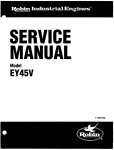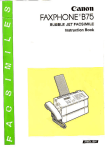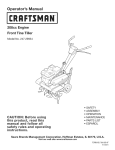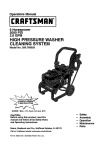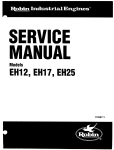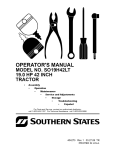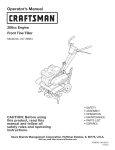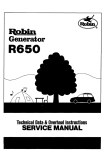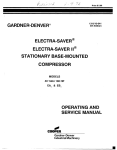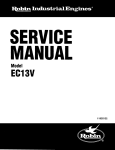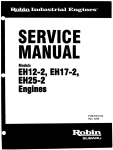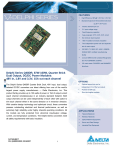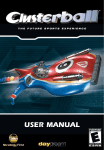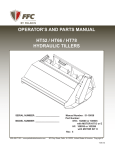Download EH18V OHV - Subaru Industrial Power
Transcript
SERVICE MANUAL IVIodel EH18V OHV 396S322 ROBIN AMERICA, INC. ROBIN TO WISCONSIN ROBIN ENGINE MODEL CROSS REFERENCE LIST WISCONSIN ROBIN ROBIN 0 SIDE VALVE W 1-080 W1-145 W1-145V W1-185 W1-185V W1-230 W 1-280 W 1-340 W 1-390 Wl-45OV EY21W EY44W EY18-3W EY25W EY27W EY08 EY15 EY 15V EY20 EY2OV EY23 EY28 EY3 5 EY40 EY45V EY2 1 EY44 EY 18-3 EY25 EY27 OVERHEAD VALVE WO1-115 wo1-120 WO1-150 WO1-170 wo1-210 WOl-250 WO 1-300 WO1-300V WO1-340 WO 1-340V WO 1-43 OV EH11 EH12 EH15 EH17 EH21 EH25 EH30 EH30V EH34 EH34V EH43V 0 TWO CYCLE WT1-125V EC13V DIESEL DY23 DY27 DY30 DY35 DY4 1 WRD 1-230 WRD 1-270 -1-300 WRD1-350 WRD1-410 0 CONTENTS . Title Section 1. SpEClF[CATlONS ......................................................................................... 2. PERFORMANCE............................................................................................ 2-1 Maximum Output .................................................................................... Page 1 2 2 2-2 Maximum Torque ................................................................................... 2 2-3 PerformanceCurves ............................................................................... 2 3 FEATURES ................................................................................................... 3 . 4.GENERAL DESCRIPTION OF ENGINE COMPONENTS 4-1 4-2 4-3 ................................. 3 4-4 4-5 4-6 4-7 4-8 4-9 4-10 4-1 1 4-12 4-13 4-14 4-15 5 . DISASSEMBLY AND REASSEMBLY............................................................ 5-1 PreparationsandSuggestions .................................................................. . 5-2 Special Tools....................................................................................... 5-3 DisassemblyProcedures ........................................................................ 5-4 ReassemblyProcedures ......................................................................... 5-5 Break-inOperation ............................................................................... 6. MAGNETO.................................................................................................. 6-1Flywheel Magneto ................................................................................ 11 11 11 12 27 40 41 Basic The0ry ....................................................................................... 41 41 6-3 WiringDiagram .................................................................................... 42 6-2 7.AUTOMATlC DECOMPRESSlON SYSTEM .................................................. 43 8.CARBURETOR ........................................................................................... 44 . 8-1 Operation and Construction .................................................................... 44 8-2 DisassemblyandReassembly ................................................................. 45 9 STARTING SYSTEM ................................................................................... 47 9-1Recoil Starter ........................................................................................ 47 . Section Title Page 10. TROUBLESHOOTlNG .............................................................................. 51 10-1 Starting Difficulties................................................................................ 51 10-2 Engine Misfires .................................................................................... 52 10-3 Engine Stops....................................................................................... 52 10-4 Engine Overheats................................................................................. 52 10-5 Engine Knocks..................................................................................... 53 10-6 Engine BacMires Through Carburetor........................................................ 53 11. lNSTALMTlON ....................................................................................... 54 11-1 Installing............................................................................................. 54 11-2 Ventilation .......................................................................................... 54 11-3 Exhaust Gas Discharge ......................................................................... 54 12. SERVICE DATA ...................................................................................... 55 12-1 Clearance Data and Limits ...................................................................... 55 12-2 Torque Specifications............................................................................ 61 12-3 Oil Grade Chart.................................................................................... 61 62 13. MAINTENANCE AND STORAGE ............................................................. 13-1 Daily Maintenance (Every 8 Hours)............................................................ 13-2 Initial 20 Hours Maintenance ................................................................... 62 13-3 Every 50 Hours (10 Days) Maintenance..................................................... 62 13-4 Every 100-200 Hours (Monthly) Maintenance ............................................. 63 62 63 13-5 Every 500-600 Hours Maintenance .......................................................... 13-6 Every 1000 Hours (Yearly) Maintenance .................................................... 63 13-7 Engine Storage .................................................................................... 63 .. 1. SPECIFICATIONS EH18V Model Air-Cooled, 4-Cycle, Vertical Shaft, Overhead Valve, Gasoline Engine TY Pe 67 X 52 mm (2.64 X 2.05in.) Bore X Stroke 183 cc (11.16 c,u.in.) Piston Displacement 4.4 /3600 KW/ rpm (6/3600 HP/rpm) Maximum Horsepower 1.29/ 2700 kg-m / rpm (9.3/2700 ft. Ibs/rpm) Maximum Torque ~ ~ ~~~~ Counterclockwise As Viewd From PTO Shaft Side Rotation Cooling ' ' Forced Air Cooling ~ Oil Pump Type Lubrication Automobile Oil SAE #20, #30or 1OW-30 Lubricant Horizontal Draft Type Carburetor I Fuel Automobile Gasoline Fuel Feed ~ ~~ Gravity Type ~ ~~ Governor System Centrifugal FlyweightType Ignition System Flywheel Magneto (Solid State) Spark Plug CHAMPION L86C Starting System Recoil Starter Dry Weight Dimensions Without P.T.0 Shaft LXWXH 17 kg (37.5Ibs.) 409 X 372 x 31 1 mm (16.10 X 14.65 x 12.24 in.) Specifications and dimensions are subject to change without notice. - 1 - 2. PERFORMANCE 2-1 MAXIMUMOUTPUT The maximum output of an engine is such a standard power as produced by the engine with its throttle valvefullyopenedafteritsinitialbreak-inperiodwhenallthemovingpartsareproperlywornin. Therefore, a new engine may not produce the maximum output in the beginning because the moving parts are not in a properly worn-in condition. 2-2 MAXIMUMTORQUE The maximum torque indicates the torque at the output shaft when the engine is producing the maximum output. 2-3 PERFORMANCECURVES EH18V 5.2; (7.0 Tn"--r ""_~_ 4.41 (6.0 """ """_ " " " 7.4! (2.0 2000 2400 2800 3200 REVOLUTlON - 3600 "i r.p.m -2- 3. FEATURES 1. Theoverheadvalvedesignofferscompactness,lightweightandidealcombustioncharacteristics resulting in more power from less fuel and prolonged engine life. 2. The parts such as a large capacity muffler, dual element air cleaner reduce noiseto a minimum level. 3. The automatic decompression system offers easy and sure starting. 4. The muffler and carburetor are located on opposite sides, making the arrangements for cooling air flow much easier in the designof power equipment. 5. The oilpumpandoilfilterprovideexcellentlubricationregardless of enginepostureduring operation. 6 . This engine is offered in two stylish versions. 7. The Pro-Poly version engine is covered witha stylishly designed shroud with the fuel tank incoroprated intoit. '8. The Classic Steel version does not have the shroud or combined fuel tank. 4. GENERALDESCRIPTION OF ENGINECOMPONENTS 4-1 CYLINDER AND CRANKCASE Thecylinderandcrankcaseissinglepiecealuminumdiecasting.Thecylinderliner,made of specialcastiron,ismoldedintothealuminum casting. Thecrankcasehasamountingsurface on the output shaft side, where the main bearing cover is attached. (See Fig. 4-1.) Fig. 4-1 4-2 MAIN BEARING COVER The main bearing cover is an aluminum diecasting, which is mounted on the output shaft side of the crankcase. Remove the main bearing cover to inspect inside of the engine. The main bearing cover also functions as an oil pan, with,a trochoid oil pump and oil filler. (See Fig. 4-2.) . . Fig. 4-2 -3- n. 4-3 CRANKSHAFT Thecrankshaftisaforgedcarbonsteel,andthe crank pin is induction-hardened. The PTO end theshafthasacrankshaftgearwhichispressed into Fig. 4-3.) r, of CRANKSHAFT GEAR Fig. 4-3 4 4 CONNECTING ROD ANDPISTON Theconnectingrod is aforgedaluminumalloy, and its large and small ends function as bearings. The piston is analuminumalloycasting,and Fig. 4-4 4-5 CAMSHAFT Thecamshaft isa hollowshaped and made of specialcast iron withthecamshaftgearcasted together. A centrifugal decompression lever is assembled on the camshaft. The lubrication oil pump isdriven by the groove on the end of the camshaft. (See Fig. 4-5.) Fig. 4-5 -4- 4-6 VALVEARRANGEMENT ' The intake valve is located at flywheel side of the cylinder head. Hard alloy valve seats are molded in the cylinder head and stellite is fused to the exhaust valve face. The cylinder baffle leads cooling air to the exhaust valve area for the optimum cooling. (See Fig. 4-6.) II EXHAUST V i Fig. 4-6 4-7 CYLINDER HEAD Thecylinderhead,isanaluminumdiecasting,. which utilizes wedge type combustion chamber for the highest combustion efficiency. (See Fig. 4-7.) Fig. 4-7 4-8 GOVERNORSYSTEM The governor is a centrifugal flyweight type which ensuresconstantoperationattheselectedspeed against load variations. Thegovernorgearwithgovernorweightsis installedonthebearingcoveranddriven by' the camshaft gear. (See Fig.4-8.) Fig. 4-8 -5- n 4-9 COOLING SYSTEM The large fins on the flywheel provide sufficient cooling air capacity for the inlet and exhaust area and cylinder. The cylinder baffle helps the cooling air flow efficiently. 4-1 0 LUBRICATION EH18V has a trochoid pump outside the main bearing cover that is driven by the camshaft. EH18V uses forced splash type lubrication. (See Fig. 4-9.) / CAMSHAFT M6 FLANGE BOLT ... 1pce. OIL SHELTER PLATE M,AIN BEARING COVER OIL PUMP COVER &Fig. 4-9 -6- M6 FLANGE BOLT ... 4pcs. 4-1 1 IGNITION SYSTEM The ignition system is transistor a controlled magneto ignition system which consists of a flywheel and an ignition coil with a built in transistor mounted on the crankcase. Thissystemhasanautomaticignitiontiming advancing for easier starting. (See Fig.4-10.) For details, refer to page 39, section 6. 4-12 CARBURETOR The engines are equipped with a horizontal draft carburetor that has a float controlled fuel system and a fixed main jet. Thecarburetorsarecalibratedcarefullyforthe surestarting, good acceleration,lowfuelconsumption and sufficient output. Forthe-datails,refer t o page42,section “8 CARBURETOR”. (See Fig. 4-11.) Fig. 4-1 1 4-13 AIR CLEANER . The air-cleaner is aheavy-dutytypewithadual elementsystem.(See Fig. 4-12.) WING BOLT GROMMET I ; ’< CLEANERCOVER eo PRIMARY ELEMENT #(URETHANE FOAM) .’: . .’ J SECONDARY ELEMENT PAPER ELEMENT) (PAPER Fig. 4-12 -7- 4-14 DECOMPRESSION SYSTEM An automaticdecompressionmechanismwhich opensexhaustvalve before thepistonreaches compression top is assembled on the camshaft for easy starting. (See Fig. 4-13) For details, refer to page 41, section 7. [ AUTOMATIC DECOMPRESSION SYSTEM &$ RETURN SPRING -a- n 4-15 SECTIONAL VIEW OF ENGINE BLOWER HOUSING RECOIL STARTER I \ COVER MAIN BEARING CRANKSHAFT -9- SPARK PLUG CONNECTING ROD MUFFLER - 10 - 5. DISASSEMBLY AND REASSEMBLY 5-1 PREPARATIONS AND SUGGESTIONS 1) When disassembling the engine, remember the locations of the individual parts so that they can be reassembledcorrectly. If youareuncertain of identifying some parts, it issuggestedthattags attached to them. Have boxes ready to keep disassembled parts by group. To prevent missing and misplacing, temporarily assemble each groupof disassembled parts. Carefully handle disassembled parts, and clean them with oil if necessary. Use the correct toolsin the correct way. be 5-2 SPECIAL TOOLS I Tool No. I I Tool Use I 228- 95003-07 I Piston ring compressor I For placing piston ring I Market parts I Flywheel puller 1 For pulling off the flywheel PISTON RING COMPRESSOR / / FLYWHEEL PULLER Fig. 5-1 - 11 - I I I 5-3 DISASSEMBLY PROCEDURES (CLASSIC STEEL)/ (PRO POLY) I I Step Part remove to 'I Spark plug II Oil drain, oil filter and bracket ~~ ~~ I Procedures Remarks (1) Remove oil gauge. (2) Remove oil drain plug and drain oil. (3) Remove oil filter. (4)Remove oil filter bracket. M6X 12mm bolt 2pcs. 14mm box wrench lOmm box wrench .... OILGAUGE T p SPARK OILGAUGE - T y OIL FILTER BRACKET ' OIL DRAIN PLUG mm SPARKPLUG Tool 19mm plug wrench Remove spark plug cap and spark plug. PLUG I ,' LTER ~ A c Clni r ... gnrc ' OIL DRAIN PLUG OIL FILTER BRACKET Fig. 5-2 - 12- M6 BOLT '.. 2 p C ~ . 5-3 DISASSEMBLY PROCEDURES (CLASSIC STEEL) -CONTINUED Part to remove Recoil starter Procedures Remove recoil starter from the engine. M6X8mm bolt 4pcs. lOmm box wrench - 0 . . Fuel tank (1) Remove fuel tank. M6X 12mm bolt . - * * 2pcs. (2) Remove fuel pipe from the fuel tank. (3) Remove side guard. M6 X 12mm bolt * Zpcs. (4) Remove bracket (fuel tank) lpce. M6X 14mm bolt ( 5 ) Remove cover (stop switch). - .... RECOIL STARTER ASS’Y M6 FL M6 FLANGE BOLT GPCS. - 8 - COVER (stop switch) HOSE CLAMP I. SIDE GUARD M6 FLANGE BOLT ... 1pce. Fig. - 13’ -’ 5-3 5-3 DISASSEMBLY PROCEDURES (CLASSIC STEEL) -CONTINUED - Step Part to remove Procedures 5 Air cleaner Remarks (1) Remove air cleaner cover and air cleaner element M6 wing bolt * * - - lpce. (2) Remove breather hose from cleaner base and crankcase. (3) Remove air cleaner base from air cleaner bracket. M6X12mm bolt Ipce. (4) Removecleaner baseand gasket (air cleaner) from carburetor. M6 nut 2pcs. (5) Remove bracket (A/C) from the engine. M6X 12mm bolt lpce. (6) Remove bracket ( N C cover) M6 X 14mm bolt 1pce. M6x 14mm tapping bolt lpce. Tool lOmm box wrench .--. lOmm box wrench .... lOmm box wrench .... - lOmm box wrench - .... PROCEED TO STEP7 OF DISASSEMBLY PROCEDURES M6 WING BOLT ... Ipce. M6 X 14mm BOLT ... lpce. AIR CLEANER COVER AIR CLEANER M6 x 14mm AIR CLEANER BASE HOSE CLAMP M6 NUT ... ~ P C S . BREATHER HOSE Fig. 5-4 - 14- 5-3 DISASSEMBLY PROCEDURES (PRO POLY)-CONTINUED Tool Remarks Procedures Step Part to remove 3 Top cover Remove top cover fromthe engine. MSX 16mm tapping screw 2pcs. (+) driver 4 Recoil starter Remove recoil starter from the engine. M6 X 12mm bolt 4pcs. lOmm box wrench 5 (1) Remove air cleaner coverand element Air cleaner M6 wing bolt 1pce. cover and engine shroud (2) Remove fuel pipe from the fuel tank (engine shroud). (with fuel (3) Remove engine shroud. tank) lpce. M6X 12mm bolt (4)Remove bracket ( N C cover) M6X14mm bolt lpce. M6X 14mm tapping bolt lpce. .. ---- 9 0 . - L SCREW TAPPING TOP COVER lOmm box wrench .... lOmm box wrench .... I . ... ~ P C S . RECOIL STARTER X 12mm BOLT . . . 4pcs. - AIR CLEANER COVER M6 X 14mm BOLT ... lpce. BRACKET (A/C cover) m TAPPING BOLT... 1pce. - 15- 5-3 DISASSEMBLY PROCEDURES (PRO POLY)-CONTINUED - Step Part to remove Procedures 6 Air cleaner Tool Remarks r: (1) Remove air cleaner element .... lpce. M6 wing bolt (2) Remove breather hose from cleaner base and crankcase. (3) Remove air cleaner base from air-cleaner bracket. M6X12mm bolt lpce. (4) Removecleanerbase and gasket (air cleaner) from carburetor. M6 nut 2pcs. ( 5 ) Remove bracket (AK) from the engine. lpce. M6X12mm bolt lOmm box wrench ---- lOmm box wrench -- lOmm box wrench .... M6 WING BOLT AIR CLEANERELEMENT Fig. 5-4 - 16- \ ' 1 . 1pce. 5-3 DISASSEMBLY PROCEDURES (CLASSIC STEEL) / (PRO POLY) Remarks Step 'art to remove Procedures 7 Speed control (1) Remove speed control assembly from the Tool lOmm box wrench crank case, then remove governor spring from the governor lever. M6X 12mm bolt 2pcs. (2) Removechoke rod fromspeed control assembly,thenremovechoke rod from choke shaft of the carburetor. .-.. 8 Governor lever lOmm box wrench (1) Remove governor lever fromthe governor shaft. M6 X 25mm bolt and washer assy 1pce. (2) Remove rod spring and governor rod from governorlever,thenremove rod spring and governor rod from throttle shaft of the carburetor. -- - r SPEED CONTROL LEVER \ W Fig. 5-6 Fig. 5-5 - 17- ' Dart to remove Remarks Procedures Carburetor (1) Remove carburetor from stud bolts. (2) Removegasket and insulator from stud bolts. Muffler ( I ) Remove muffler cover from muffler. M5X lOmm tapping screw 3pcs. (2) Remove muffler and gasket. (muffler) M8 X70rnm bolt andwasher assy .... Tool (+) driver 12mm box wrench -*..Zpcs. M8 X 16mm bolt andwasher assy .*.-lpce. M5 x 10mm TAPPING SCREW ... 3pcs. \ MUFFLER COVER I M8 x 16mm BOLT AND CARBURETOR Fig. 5-7 - 18- Step Part to remove 11 Remarks Procedures Tool Remove the clamp from oil filler, and remove oil filler bracket. M 6 X 12mm bolt Ipce. I O m m box wrench Blower hausing Remove the blower housing crankcase. M6x 12mm bolt 2pcs. M 6 X 14mm bolt lpce. lOmm box wrench Ignition coil (1) Disconnectstopswitchwire from stop switch. (2) Remove ignition coil from crankcase. M6 X 30mm bolt 2pcs. Oil filler -- 12 13 from the .... .... -- - e - 19- lOmm box wrench I Part to remove I Flywheel I Procedures Remarks I ( 1 ) Remove starter pully from flywheel MI4 n u t Ipce. (2) Remove flywheel from crankshaft. (See Fig. 5-1 1.) 18mm box wrench (3) Remove key from crankshaft. (-) driver I e M14 NUT '.. lpce. STARTER PULLEY Fl Tool & Fig. 5-10 KEY \ Fig. 5-9 Fig. 5-12 -20- I Step Part to remove 15 Brake assy Remarks Procedures (1) Remove brake assy. M6 X 12mm bolt -- TooI lOmm box wrench 4pcs. M6 x 12mm BOLT ... 4pcs. BRAKE ASSY \ Fig. 5-13 -21 - Step Part to remove 16 Cylinder Cylinder head Remarks Tool 1Omm box wrench (1) Remove cylinder baffle. M6X8mm bolt 17 Procedures *.-- lpce. (1) Removerockercover and guide plate from cylinder head. M6 X 12mm bolt 4pcs. (2) Loosen lock nut for rocker arm adjusting screw. M8 lock nut 2pcs. (3) Slide off rocker arm shaft from the holder to the flywheel side, remove rocker arms. (See Fig. 5-1 5 . ) (4)Remove push rods. (5) Remove cylinder head and gasket. M8X65rnm bolt 2pcs. M8X40mm bolt . - - lpce. M8 flangenut 1pce. lOmm box wrench 12mm box wrench - 12mm box wrench -.... Fig. 5-14 Fig. 5-15 -22- Step - 'art to remove Remarks Procedures 18 Intake and (1) Press down spring retainer and slide it to exhaust valve release from the groove of valvestem, then removespring retainer andvalve spring. (See Fig. 5-16.) (2) Remove intake andexhaustvalves from cylinder head. 19 Breather Clean carbon and gum deposits from the valves, valve seats, ports and guides. Inspect valves, valve seats and guides. (1) Remove breather cover. M6 X 12mm bolt 2pcs. Remove gasket (tappet cover), breather plate and gasket (breatherplate). lOmm box wrench . - Tool INTAKE VALVE EXHAUST VALVE I I M6 x 12mm BOLT Fig. 5-17 VALVE SPRING \\ RETAINER COLLET Fig. 5-16 -23 - ... 2pcs. / Part to remove Mainbearing (See cover Procedures Remarks Fig. 5-18.) M6X30mm bolt and washer assy * e * . Oil pump Do not lose spacer for crankshaft. (1) Remove mainbearing cover. cover. M6 X 12mm bolt 4pcs. (2) Remove oil pump(Inner) and oil pump (Outer). - fi I M6 x 12mm BOLT '.' lOmm boxwrench 8 ~ ~ s . (1) Remove oil pumpcoverfrom main bearing OIL PUMP COVER Tool 4pcs. Fig. 5-1 9 -24 - lOmm box wrench B Step Part to remove 22 Camshaft and tappets 1 Procedures Tool Remarks (1) Remove camshaft from crankcase. (See Fig. 5-20.) To prevent the tappets from getting damages, put the crankcase cylinder side down. (See Fig.5-20.) Tappet must be installed in their original position. Mark tappets prior to removal to prevent error. (2) Remove tappets from crankcase. - /, /, I ,/' f CAMSHAFT I TAPPET I /' I I Fig. 5-20 -25- I Step Part to remove 23 I Procedures (1) Remove connecting rod bolts and connecting rod cap. Connecting rod bolt 2pcs. (2) Turn crankshaft until piston is at top dead center, push out connecting rod and piston assembly through top of cylinder. (3) Remove clips and piston pin to remove connecting rod from piston. (4)Remove piston rings from piston. L 24 I I I Connecting rod and piston Crankshaft Tool Remarks I Scrape off all carbon might deposits that interfere with removal of piston from upper end of cylinder. lOmm box wrench Ring expander (l).Tap lightly on flywheel end of crankshaft to remove from crankcase. (See Fig.5-22.) M 0 W \ CONNECTING ROD CAP SPACER f- Fig. 5-22 Fig. 5-23 -26- 5-4 REASSEMBLYPROCEDURES 0 PRECAUTIONS .FOR REASSEMBLY 1) Clean parts thoroughly’before reassembly. Pay utmost attention to cleanliness of piston, cylinder, crankshaft, connectingrod and bearings. 2) Scrape off all carbon deposits from cylinder head, piston top and piston ring grooves. 3) Check lip of oil seals. Replace oil seal if the lip is damaged. Apply oil to the lip before reassembly. 4) Replace all the gaskets with new ones. 5) Replace keys, pins, bolts, nuts, etc., if necessary. 6) Torque bolts and nuts to specification referring to page59 “12-2 TORQUE SPECIFICATIONS” 7 ) Apply oil to rotating and sliding portions. 8) Check and adjust clearances and end plays where specified in this manual. 5-4-1 CRANKSHAFT (1) Installcrankshaftoncrankcaseusinganoil sealguidetoavoiddamagetocrankshaft seal. (See Fig. 5-24.) oil Fig. 5-24 -27 - 5-4-2 PISTONANDPISTONRINGS (1) Install oil ring first, then second ring and top ring. Spread ring only far enough to slip over piston and into correct groove. Use care not to distort ring. (See Fig. 5-26.) Fig. 5-25 EN ENDS OF PI Fig. 5-26 5-4-3 PISTONANDCONNECTINGROD Install piston on connection rod. Oil the small end of connecting rod before installing piston and piston pin. Use clips on both side of the piston pin to secure piston pin in position. Fig. 5-27 -28- 5-4-4 CONNECTING ROD (1) Before installing the piston and connecting rod in the cylinder, oil the piston, piston rings and cylinder wall. (2) Stagger the piston ring gaps 90” apart around the piston. (See Fig. 5-28.) Useapistonringcompressorwheninstalling piston. Install piston and rod with the “MA” marks on flywheel side of the crankcase. (See Fig. 29.) (3) Turn crankshaft to bottom dead center, then tap lightly top of the piston until large end of the connecting rod meets crank pin. Fig. 5-28 PISTON RING COMPRESSOR CONNECTING ROD CRANKCASE Fig. 5-29 (4)Install connecting rod cap with the match mark on themainbearingcoverside.(Matchthis markwiththeone on theleftside of connectingrod’slargeendviewedfrommain bearing cover side.) (See Fig. 30) Connecting rod bolt 2 pcs. - 0 . - Tightening torque 17-20 N*m 170-200 kg-cm 12.2-14.5 ft4b Fig. 5-30 Checkforfreemovemont of connectingrod by turning crankshaft slowly. -29 - 5-4-5 TAPPET AND CAMSHAFT (1) Oil tappets and install in their original position. Push in fully to avoid damage during camshaft installation. (2) Lubricate bearing surfaces of camshaft. on camshaft and install camshaft Align timing mark on crankshaftgearwithtimingmark crankcase. (See Fig. 5-31.) Incorrect valve timing will cause engine's malfunction. CRANKSHAFT CAMSHAFT Fig. 5-3 1 - 30 - in the r' PLAY 5-4-6 ADJUSTCRANKSHAFTEND (1) Adjust end play to the,specified values using the proper spacer. The proper spacer. may be determined by the following manner. MAIN BEARING COVER I , R1 ”7- I Fig. 5-32 0 CRANKSHAFT END PLAY (1) Measure the depth “ A l ” (From the mating surface to the inner raceof the ball bearing.) (2) Measure the height “Bl” (From the mating to the crank gear.) (A1+0.3) - Bl=SIDE CLEARANCE (mm) (SIDE CLEARANCE) - 0.2=THICKNESS OF CRANKSHAFT SHIM (mm) (A+0.012) - Bl=SIDE CLEARANCE(in) SIDE CLEARANCE - 0.008=THICKNESS OF CRANKSHAFT SHIM (in) Following are available spacer shims. 1 CRANKSHAFT ~~ . SPACER SHIMS T=0.6 mm (0.024”) T=0.8 mrn (0.031”) T=l .O mrn (0.039”) - 31 - ~~ 5-4-7 MAIN BEARING COVER (1) Install oil pump to the main bearing cover. M 6 X 12mm bolt KEY 4 pcs. .... CRANKCASE 8-9.5 N*m 80-1 00 kgcm 6-7 ft*lb Lubricatethe oil sealandbearingsurfaces. Add a light film of oil on the main bearingcoverface to hold thegasket in place. Placespacerschosen atprocedure5-4-6 on crankshaft. Use an oil seal guide when installing the main bearing cover to avoid damaging the seal. Tap the cover into place with a soft hammer. Main bearing cover. M6 X 30 mm bolt and washer 8 pcs. CRANKSHAFT -.-. Tightening torque 8-9.5 Nom 80-1 00 kgocm 6-7 ft*lb OIL PUMP (INNER) 0 RING M6 BOLT AND WASHER ASS'Y ... ~ P c s . OIL PUMP COVER M6 BOLT ". ~PCS. Fig. 5-33 -32 - 5-4-8 BREATHERVALVE Attach breather plate (breather valve) and breather cover to crankcase using proper gaskets. (See Fig. 5-34.) Replace gaskets with new ones if they are torn or damaged. Replace breather hose at least once a year or when ever a crack was found. Fig. 5-34 5-4-9 CYLINDERHEAD (1) Clean carbon and gum deposits fromthe valves, seats,portsandguides.Inspect the valves, valve seats and valve guides. (2) Replace valves that are badly burned, pitted or warped. (3) When installing the valves in the cylinder head, oil thevalvestemsandinsertthem into the valve guide. Then place the cylinder head on a flat table, install the washer, valve spring and spring retainer. (See Fig. 5-35.) (4)Valveguidesshouldbereplacedwhenthe valvestemclearanceexceedsspecifications (See “SERVICE DATA’ page 57) Draw the valve guides out and press the new guides in. Refer to “SERVICE DATA” for clearance specifications. Afterreplacingthevalvesandguides,lap shows valves in place until a uniformring around the face of the valve. Clean valves and wash cylinder head thoroughly. ( 5 ) Install cylinder head to cylinder with new head gasket. r When installing head gasket, show Fig. 5-36. Tightenthreeflangeboltsand a flange nut evenly in threesteps by thefollowingtightening torque: 2 pcs. Cylinder head M8 X 65 mm bolt M8 X 40 mm bolt 1 pce. M8 flange nut .. 1 pce. ...-.*. .. e.. 1st step 50 kgocrn 3.6 ft*lb Tightening torque 2nd step 10 N-m 100 kgocrn 7.2 ft-lb final step 23-26 Nom 230-270 kgmn 17-30 ft*lb -33- INTAKE VALVE Fig. 5-35 5-4-10 ROCKER ARMSAND PUSH RODS (1) Insert push rods into crankcase. Put push rod tip in the hollow of tappet top. ( 2 ) Apply oil to the rocker arms and assemble them to the cylinder head using the rocker shaft and spacer. \ 5-4-1 1 VALVE CLEARANCE ADJUSTMENT (1) Position the piston at the top dead center of the compression stroke. The top dead center may obtained by placing the key slot on the power take off shaft to 45" from the center of cylinder. Fig. 5-37 (2) Loosen the lock nut on the rocker arm and turn the adjusting screw to adjust the clearance between the rocker arm and the valve stem end. (See Fig. 5-38.) Tighten the lock nut. 0.085-0.1 15 mm - [NOTE) Check and adjust valve clearance with engine cold. Check operationof valves by turning crankshaft. Remeasure valve clearance. (3) Install guide plate and rocker cover using a gasket. M 6 X 12 mm bolt 4 pcs. -34- be ,' 54-12 BRAKE ASSEMBLY Install brake assy to the engine. M6 X 12 m m bolt . 4 pcs. 80-100 kg-cm Never apply oil or (grease) on the internal of flywheel and brake. 5-4-13 FLYWHEEL MAGNETO (1) Put the woodruff key in the key way of crankshaft. Wipe off oil and de-grease thoroughly from the taperedportion of the crankshaft and the flywheel center hole. (2) Pull the brake lever. (31 Install the flywheel to crankshaft. Tighten the flywheel nut with the starter pulley. (See Fig. 5-39.) I RANKSHAFT I- Tightening torque 59-63 Nom Fig. 5-39 600-650 kgocrn 43-47 ft'lb 5-4-14 IGNITION COIL Install the ignition coil to the crankcase. Adjusttheairgapbetweentheignitioncoiland the flywheel using a thickness gauge (filler gauge) and tighten the bolts. (See Fig. 5-40.) M6 X 30 m m bolt 2 pcs. -- I I Air gap 0.3-0.5mm 0.012-0.020in. I I Fig. 5-40 -.35- 5-4-15 BLOWER HOUSING AND BRACKETS Install blower hosing, oil filler bracket (fuel tank) and air cleaner bracket. BLOWER HOUSING M6 x 12mm M6 x 14mm BOLT '.' 3PcS. \ BOLT ... lpce. Classic Steel -.- 1 pce. .... 3 pcs. M 6 X 12 mm bolt M 6 X 14 m m bolt Pro Poly M6 M6 X X - 2 pcs. 12 m m bolt 14 m m bolt - - e . 2 pcs. 5-4-16 CYLINDER BAFFLE Install cylinder baffle. M 6 X 8 m m bolt 1 pce. 54-17 OIL FILLER Install oil filler to the engine. M 6 X 12 m m bolt 1 pce. I TAPPING BOLT... 1Dce Fig. 5 4 1 (Classic Steel) .... ~~~ \v M6 x 12mm BOLT ... 2pcs. 5-4-18 CARBURETOR M6 x 14mm BOLT ... 2pCS. Install the gaskets, insulator and carburetor. M 6 x 14mm BOLT ... 2pcs. ENGINE SIDE. GASKET 2 (INSULATOR) CABURETOR I \ - TAPPING BOLT ... lorn. Fig. 5-41 (Pro Poly) Fig. 542 -36- J 5-4-19 AIR CLEANER (1) Install cleaner base on studs, install bracket, cleaner Tighten the clamp.for stop switch wire together with cleaner bracket on crankcase side. M6 Nut **..~ P C S . . I Tightening torque SLOW AIR BLEED JET 8-9.5 N*m 80-1 00 k g c m AIR VENT HOLE [NOTE] Attachtheaircleanergaskettothecarburetor flangewheninstallingaircleanerbase on the engine. (See Fig.5-43.) MAIN AIR BLEED JET (2) Install cover and element to the air cleaner base.I bolt M6 wing (3) Connect a breather pipe between breather and air cleaner. Fig. 5-43 Fig. 5-44 Fig. 5-45 5-4-20 GOVERNOR ADJUSTMENT Forcorrect Carburetor throttleopeningandgovernor regulation, the governor lever must be properly adjusted. (1) Installthrottlelever,controllinkageongovernorleverandchokeshaftcontrol rodin choke lever. (2) Hook spring from control lever hole (A) to the hole (B) in governor lever as shownin Fig. 5-44. Install bracket assembly on crankcase. (3) Install governor lever on governor shaft but do not tighten clamp screw. (4) Turngovernorleverclockwiseuntilthrottle valve. in carburetor is opened fully. Hold lever in this position. (See Fig. 5-45.) Check that governor lever clamp screw is loose so governor shaft can be turned independently of ( 5 ) Insert a screwdriver in slot at end of governor shaft.Turnclockwiseasfarasshaftcanbe turned. Tighten governor lever clamp screw. -37- 5-4-21 MUFFLERANDMUFFLERCOVER (1) Install muffler and muffler gasket. M8 X 70 m m bolt and washer assy M 8 X 16 m m bolt and washer assy .-..2pcs. .... lpce. Tightening torque 22.5-26.5 Nom 230-270 kgecrn 16.6-1 9.5 ft*lb (2) Install muffler cover to the muffler. M5 X 10 mm Tapping screw 3 pcs. -- TANK (if applicable) (1) Install fuel tank bracket. M 6 X 12 m m bolt 2pcs. (2) Install fuel tank. M 6 X 1 2 mm bolt 2pcs. (3) Install side guard. M 6 X 12 m m bolt 2pcs. (4) Install cover (stop switch). 5-4-22 FUEL -.- .... . 5-4-23 RECOIL STARTER AND ENGINE SHROUD (1) Install recoil starter and engine shroud. M6 X 8 mm bolt 4pcs. (2) Connect fueI pipe between fuel cock and carburetor. --.e 5-4-24 OIL FILTER BRACKETAND OIL FILTER (1) Install oil filter bracket M 6 X 1 2 mm bolt 2pcs. -... I Tightening torque I 8-9.5 Nom 80-100 k g w n 6-7 ft*lb / (2) Tighten filter using a proper tool about 3/4 turn after gasket contacts mounting surface OIL FILTER BRACKET of engine. Fig. 5-46 Check for leaks at testrunningafterengine assembly is completed. -38- \ OIL FILTER 5-4-25 SPARK PLUG (1) Install spark plug to the cylinder head. Spark plug : CHAMPION L86C I I L 1 Tightening torque ________~~~ ~~~ New spark plug 1 1.8-1 4.7 N-m Retightening 22.6-26.5 N*m I 120-1 50 kgocm 230-270 kg-cm I 16.6-1 9.5 fblb 8.7-1 0.9 ft*lb (2) Connect spark plug cap to the spark plug. 5-4-26ENGINE OIL After complete reassembly, turn the engine over and pull the recoil starter to check for any abnormal conditions or loose fitting parts. Review and check wiring. Fill crankcase with correct grade of oil. (See page 59, "OIL GRADE CHART ") Crankcase oil capacity : 500cc 5-4-27 CHOKE AND SPEEDADJUSTMENT (1) Start the engine. (Operate the engine without load.) (2) In order to fix the position of the speed control lever, insert a philips screw driver into the hole (A) of the speed control lever through the hole of the speed control bracket. (3) Loosen the adjusting screw on the speed control lever. (4) Check the engine speed by a tachometer or a revolution counter. Correct engine speed is 3350 r.p.m. (5) Loosen the bolts (B) and (C), Move the speed control bracket to the position where the engine speed become 3350 r.p.m. In order to reduce the engine speed move the speed control bracket -to the left. (6) After adjusting the engine speed, re-tighten the two bolts(B) and (C) to fix the bracket. (7) Tighten the adjusting screw until it contacts the choke lever. CHOKE LEVER A \ ROD SPRING SPEED CONTROL LEVER SCREW (PAN HEAD) \ \ n"L B LOW SPEED When speed control bracket is moved in the direction of the arrow,. engine speed is reduced. Fig. 5-47 -39 - e 5-5 BREAK-IN OPERATION An engine that has been completely overhauled by being fitted with a new piston, rings, valves and connecting rod should be thoroughly RUN- IN before being put back into service. Goodbearingsurfacesandrunningclearancesbetweenthevariouspartscanonlybeestablished operating the engine under reduced speed and loadsfor a short period of time. While the engine is being tested, check for oil leaks. Make final carburetor adjustment and regulate the engine operating speed. I speed Steps Step 1 Step 2 Step 3 Step 4 Engine Load No load 2500 rpm 10 min No load 3000 rpm 10 min 2.0 HP 3000 rpm 30 rnin 4.0 HP 3000 rpm 60 min - 40- by 6. MAGNETO 0 " . 6-1 FLYWHEEL MAGNETO The ignitionsystem of the EH18V isapointlessflywheelmagneto.withanautcmaticadvancing characteristic. Being different from the breaker point type ignition system, this- system is completely free from such troubles as starting-up failure due to dirty, burnt or corroded point surface. The electronic automatic advancing ensures extremely easy starts and stable high performance at operating speed by advancing the ignition timing to the most suitable point. 6-2 BASIC THEORY . To ensure the easy startability of the engine, the step advancing ignition timing system is incorporated in theignitioncoil.Thissystemenablestheenginetohavebasicallytwodifferentignitiontimings according to the engine speed. Following are the explanation how the system works. 1)At lower speedof the engine Rotation of the flywheel induces current I,, as this current flows through the base terminalof the power transistor, it is activated and the current LZstarts flowing. As the engine reaches the ignition timing, the ignition timing control circuit for the lower engine speed is activated and lets the currentb flow through the base terminal of the power transistor. This generates the collector currentL which will bypass the current11 and abruptly shut off the current IZ because the power transistor is turnedoff. This sudden current change generates a big voltage on the secondary side of the ignition coil and which sparks the spark plug. 2)At the higher engine speed Rotation of the flywheel generates the current 11 as this current flows through the base terminal of the power transistor, it is activated and the current 12 starts flowing. As the enginereachestheignitiontiming,theignitiontimingcontrolcircuitforthehigherengine speed is activated and provides the base current Is to the power transistor. This current induces the collector current 16 and will bypass the current IL to shut down the current IZ abruptly because the power transistor is turned off. This sudden current change generates a big voltage on the secondary side of the ignition coil causing sparks at the spark plug. The ignition timing control circuit for the higher engine speed is activated sooner than the control circuit for the lower speed andnot activated when the engine speed is in a lower range. -41 - ELECTRONIC ADVANCING FLYWHEEL MAGNETO SYSTEM (B.T.D.C.) 23" . 1 4I F 15.1 STEP ADVANCING , 500 , , I 1000 2000 ENGINE REVOLUTION 3000 (r.p.m.) Fig. 6-2 6-3 WIRINGDIAGRAM STANDARD Stop switch Flywheel Fig. 6-3 -42 - 7. AUTOMATIC DECOMPRESSION SYSTEM The decompression system operates to release compression by lifting up the exhaust valve at starting. The release lever mounted on the camshaft has a flyweight at one end and a crescent cam at the other end. When starting the engine, the crescent cam juts out from the exhaust cam. The exhaust tappet rides over the crescent cam opening the exhaust valveto release compression. LEVER CRESCENT CAM EXHAUST CAM Fig. 7-1 a When the crank speed reaches a certain revolution, the flyweight of the release lever moves outward by the centrifugal force turning the release lever to retract below the crescent cam. Thus the exhaust valve closes allowing a sufficient compression for the engine to start up. FLYWEIGHT LEVER CRESCENT CAM Fig. 7-2 -43- 8. CARBURETOR 8-1 OPERATIONANDCONSTRUCTION (See Fig. 7-2. and SI.) 8-1 -1 FLOATSYSTEM The float chamber is located just below the carburetorbody.and,withafloatandaneedlevalve, maintains a constant fuel level during engine operation. Thefuelflowsfrom the fueltankintothefloat chamber through needle valve. When the fuel rises toaspecificlevel,thefloatrises ; andwhenits buoyancy and fuel pressure are balanced, the needle valve closes to shut off the fuel, thereby keeping the fuel at the predetermined level. FLOAT u '\ Fig. 8-1 ' PILOT Fig. 8-2 -44- PILOT JET 8-1-2PILOT SYSTEM The pilot system feeds the fuel to the engine during idling and low-speed operation. The fuel is fed through the main jetto the pilot jet, where it is metered, and mixed with the air metered by the pilot air jet. The fuel-air mixture is fedto the engine through the pilot outlet and the bypass. At idling speed, the fuel is mainly fed from the pilot outlet. 8-1-3 MAINSYSTEM The main system feeds the fuel to the engine at medium- and high-speed operation. The fuel is metered by the main jet and fed to the main nozzle. The air metered by the main air jet is mixed with the fuel through the bleed holes in the main nozzle, and the mixture is atomized outof the mainbore. It is mixedagainwiththeairtakenthroughtheaircleanerintoanoptimumfuel-air mixture, which is supplied to the engine. 8-1 -4 CHOKE The choke is used for easy start when engine is cold. When the starter is operated with a closed choke, the negative pressure applied to the main nozzle increases and draws much fuel according1y;thus easily start up the engine. 8-2DISASSEMBLYANDREASSEMBLY Apart from mechanical failures, most of carburetor troubles are caused by an incorrect mixing ratio, which may arise mainly due to a clogged up air or fuel passage in jets, or fuel level variations. In order to assure proper flow of air and fuel, the carburetor must be kept clean at all times. The carburetor disassembly and reassembly procedures are as follows : (See Fig. 8-2.) 8-2-1 THROTTLE SYSTEM (1) Remove the philips screw (15) and throttle valve (14), and pull out the throttle shaft(l3). (2) The spring (19) can be taken out by removing the throttle stop screw (20). * Exercise carenot to damage throttle valve ends. 13 8-2-2 CHOKESYSTEM (1) Remove the clip (23) and choke valve (17), and pull out the choke shaft(16). (2) Whenreassemblingthechokeshaft,makesure that the cutout in the choke valve faces the main air jet. 24 8-2-3 PILOTSYSTEM (1) Remove the pilot jet (18), using correct tool to avoid damage to it. (2) Reassembly Tighten the pilot jet securely. Otherwise, the fuel may leak, causing engine malfunction. 10 1-@ -"- Fig. 8-3 - 45 - 8-24 MAIN SYSTEM (1) Remove the bolt (11)and take out float chamber body (5). (2) From the body (3) remove the main jet (9). (3) Reassembly a)Fasten the main jet securely to the body. Otherwise, the fuel may become too rich and cause engine malfunction. b) The bolt tightening torque is 80 kg-cm. 8-2-5 FLOAT SYSTEM (1) Pull out the floatpin (8) and remove the float(7) and needle valve (6). When cIeaning the jets, use neithera drill nor a wire (because of possible damageto the orifice which will adversely affect fuel flow). Be sure to use compressed to airblow them clean. (2) When removing the needle valve and floats, gently tap the reverse side using the rod more slender than the float pin and remove, since the floatpin is calked to the carburetor body. - n -46 - 9. STARTING SYSTEM 9-1 RECOIL STARTER When repairing recoil starter, disassemble and reassemble in the following procedures. Tools: Socket wrench, Needle nose pliers, Screw driver 9-1-1 HOW TO DISASSEMBLY (1) Remove recoil starter from engine. (2) Pull starter knob and pull out starter rope for 30-40cm to line up notch on reelwithoutlet hole for starter rope. Holdreelwiththumbandpullstarterrope inside the starter case with screw driver. (See Fig. 9-1 or 9-2.) Rewind reel clockwise until the rotation stops. Whenrewindingthereel,controltherotation by holding starter rope using the notch on the reel and pressing the reel with thumb. (3) Remove parts in the following order. 1. Return spring 2. Rachet 3. Friction spring 4. Rachet guide 5. Set screw 0-3 Fig. 9-1 (Classic Steel) STARTER ROPE -3 4 &--" Fig. 9-2(Pro Poly) -47- (4) Remove the reel from the starter case as shown in Fig. 9-3. Takeoutthereelslowlyturningitlightly to removespring towardstheleftandright from the hook. Do not remove the reel quickly or the spring may escape from the starter case. Untie the starter rope from the knob and remove. STARTER CASE STARTERCASE Pro Poly L Fig. 9-3 9-1-2 HOW TO REASSEMBLE (1) Put thestarterropethroughthestarterknob and tie it as shown in Fig. 9-4. (Tie the rope tightly for the safety sake.) Put the opposite side of the rope through the starter case and reel. Tie it in the same way as the starter knob end and put the knot in the reel completely. (2) Check that the springis securely set in the reel. Adjust the position of inner end of the spring so it hooks on hook in the starter case securely. The shape of starter spring inner end may be adjusted with a plier if necessary. Fig. 9-4 I / OUTER END OF SPRING SPRING KEEPER ' BEARING REEL I INNER END OF SPRING Fig. 9-5 -48- (3) Prior to installing the reel in the starter case, wind the starter rope in the reel for 2.5 turns in the arrowhead direction as shownin Fig. 9-6. Then let the rope out of the reel from the reel notch. Line, up the reel hook with the inner end of the spring and install the reel in the starter case. Check that the inner end of spring is securely hooked onto the hook. Fig. 9-6 (4)Reassemble the parts in reverse order of disassembly. Checkthattheratchetsarepushed by the ratchet springs toward the center of the recoil. Install the friction plate with its two bosses set inside of the bent portion of ratchets. Apply small amount of lock-tight to the center screw and torque it. I Classic Steel I Pro Poly C~-FRICTION SPRING -RATCHET GUIOE & S -ET SCREW Thightening torque 3.9 Nom 4.0 kg*crn 2.9ft4b 0-FRICTION SPRING “RATCHET GUIDE SET SCREW Fig. 9-7 (5) Holdstarterropeasshown in Fig. 9-8 and turn reel 4 times in the arrowhead direction. Firmly press the reel not to allow reverse turn and pull starting knob to let starter rope out of starter case. Return knob slowly to let starter rope rewind in reel. Pro Poly Fig. 9-8 -49- ( 6 ) Test the operation of the recoil starter to see if theroperecoilssatisfactorilyandtheratchets project and retract properly. Mount the recoil starter to the engine. (7) If the spring escapes from the reel when disassembling the recoil, hook the outer endof the spring onto the notch of the reel and rewind the spring into the housing. (8) Lubricate the rotating parts, sliding parts and spring with heat resistant grease or mobile oil when reassembling the recoil and prior to longterm storage. -50- IO. TROUBLESHOOTING a The following three conditions must be fulfilled for satisfactory engine start. 1. The cylinder filled with a proper fuel-air mixture. 2. Good compression in the cylinder. 3. Good spark, properly timed, to ignite the mixture. The engine cannot be started unless these three conditions are met. There are also other factors which make engine start difficult, e. g., a heavy load on the engine when it is about to start at low speed, and a high back pressure due to a long exhaust pipe. The most common causesof engine troubles are given below: 10-1 STARTINGDIFFICULTIES 10-1-1 FUEL SYSTEM (1) No gasoline in the fuel tank ; or the fuel cock closed. (2) The carburetor is not choked sufficiently, especially when the engine is cold. (3) Water, dust or gum in the gasoline interfering the fuel flowto the Carburetor. (4) Inferior grade gasoline or poor quality gasoline is not vaporized enough to produce the correct fuel-air mixture. (5) The carburetor needle valve is held open by dirt or gum. This trouble can be detected as the fuel flows out of the carburetor when the engine is idling. (Overflow) This trouble may be remedied, depending on cases, by lightly tapping the float chamber with the grip of a screwdriver or the like. (6) If the carburetor overflows, excessive fuel runs into the cylinder when starting the engine, making the fuel-air mixture too rich to burn. If this happens, remove the spark plug, and turn the starting pulleyafewturns in ordertolettherichfuel-airmixtureout of the spark plug hole into the atmosphere. Keep the carburetor choke open during this operation. Dry the spark plug well, screw it into place, and try to start again. 10-1-2 COMPRESSIONSYSTEM If startingdifficultiesandloss of powerarenotduetothefuelsystemorignitionsystem,the following must be checked for possible lack of compression. (1) Engine inside is completely dried up because of a long period of storage. (2) Looseorbrokensparkplug.Thiscausesahissingnoisemadebymixturegasrunningout of cylinder in compression stroke during cranking. (3) Damaged head gasket or loose cylinder head. A similar hissing noise is produced during compression stroke. (4) Incorrect valve clearance If the correct compression is not obtained even after remedying the above, disassemble the engine and check further as follows: a) Valve stuck open due to carbon or gum on the valve stem. b) If the piston rings are stuck on the piston, remove the piston and connectingrod from the engine. Clean or replace the parts. -51 - 10-1-3 IGNITIONSYSTEM Check the followings for lackof spark . (1) Leads of the ignition coil or spark plug. (2) Ignition coil damaged and shorted. (3) Spark plug cable wet or soaked with oil. (4)Spark plug dirty or wet. ( 5 ) Spark plug electrode gap incorrect. (6) Spark plug electrodes are connected or bridged. (7) Incorrect spark timing. 10-2 ENGINEMISFIRES (1) Incorrect spark plug electrode gap. Adjust it to anywhere between 0.7 and 0.8mm. (2) Ignition cable worn and leaking. (3) Sparks weak. (4)Ignition wire connections loose. ( 5 ) Water in gasoline. (6) Insufficient compression. 10-3 ENGINE STOPS (1) Fuel tank empty. Water, dirt, gum, etc. in gasoline. (2) Vapor lock, i. e., gasoline evaporating in the fuel lines due to overheat around the engine. (3) Vapor lock in the fuel lines or carburetor due to the useof too volatile winter gas in the hot season. (4)Air vent holein the fuel tank cap plugged. ( 5 ) Bearing parts seized due to lackof oil. (6) Magneto or ignition coil faulty. 10-4 ENGINEOVERHEATS (1) Crankcase oil level low. Add oil immediately. (2) Spark timing incorrect. (3) Low grade gasoline is used, or engineis overloaded. (4)Cooling air circulation restricted. ( 5 ) Cooling air path misdirected causes lossof cooling efficiency. (6) Cylinder head cooling fins clogged up with dirt. (7) Engine operated in an enclosed space without sufficient cooling air. (8) Exhaust gas discharge restricted, or carbon deposits in the combustion chamber. (9) Engine running on low- octane gasoline detonates due to heavy loadat low speed. - 52 - 10-5 ENGINEKNOCKS gasoline. quality (1) Poor (2) Engine operating under heavy loadat low speed. (3) Carbon or lead deposits in the cylinder head. (4)Spark timing incorrect. ( 5 ) Loose connecting rod bearing due to wear. (6) Loose piston pin due to wear. (7) Engine overheated., I . 10-6 ENGINEBACKFIRESTHROUGHCARBURETOR (1) Water or dirt in gasoline, or low-grade gasoline. (2) Intake valve stuck. (3) Valves overheated, orhot carbon particles in the combustion chamber. (4)Engine cold. - 53 - 11. INSTALLATION Engine life, ease of maintenance and inspection, frequency of checks and repairs, and operating cost all depend on the way in which the engine is installed. Carefully observe the following instructions for installing the engine. 11-1 INSTALLING When mounting the engine, carefully examine its position, the method of connecting it to a machine, the foundation, and the methodof supporting the engine. When determining its mounting position,, in particular, make sure that gasoline and oil can easily be supplied and checked, the spark plug can easily be checked, the air cleaner can easily be serviced, and that the oil can easily be discharged. 11-2 VENTILATION Fresh air is necessary for cooling the engine and burning the fuel. In the case the engine is operated under a hood or in a small room, temperature rise in the engine room loss of power,pistonseizure, cancausevaporlock,oildeterioration,increasedoilconsumption, shorter engine life, etc., making it impossible to operate the engine properly. It is necessary, therefore, to provide a duct or baffle to guide cooling air to the engine to prevent recirculation of the hot air used of the machine. for engine cooling, and temperature rise Keep the engine room temperature below50°C even in the hottest period of the year. 11-3 EXHAUST GAS DISCHARGE Exhaustgas isnoxious.Whenoperatingtheengineindoors,besuretodischargetheexhaustgas outdoors. If a long exhaust pipe is used in such a case, the internal resistance increases causing loss of engine power. Thus pipe inside diameter must be increased in proportion to exhaust pipe length. Exhaust pipe: Less than 3m long, pipe inside diameter25 mm, Less than 5m long, pipe inside diameter 30 mm. -54- 12. SERVICE DATA “STD” in the following table is the parts dimension from the brand new engineor the spare parts. Whereas, “Limit” shows the maximum allowance for the parts to be used on the engine. If the measurement exceeds beyond the “Limit”, the part needsto be replaced and/or repaired. 12-1 CLEARANCE ‘DATA AND LIMITS Unit : rnm (in) ITEM Limit STD CYLINDER HEAD LESS THAN 0.1 (0.004) 0.05 (0.002) 0 Valve seat contact width IN. EX. - 0.7 1 .O (0.028 0.039) 2.0 (0.079) - Valve guide inside dia. - 5.500 5.51 8 (0.21 65 0.21 -55- 72) 5.65 (0.2224) Unit : mm (ir T ITEM CYLINDER 0 Inside dia. STD Lmit STD - 67.000 67.019 (2.6378 2.6385) To be rebored whenthe difference between max. and min. of diameter reached to 0.1 (0.004). 0 1st reboring 67.250 (2.6476 - 67.269 - 2.6484) 2nd reboring 67.500 (2.6575 - 67.519 - 2.6582) Ditto Roundiness after reboring LESS THAN 0.01 (0.004) 0 Cylindricity after reboring. LESS THAN 0.015 (0.0006) PISTON 0 Piston size (Atskirt in thrust direction) STD - 66.96 66.98 (2.6362 - 2.6370) 66.87 (2.6327) - 67.23 - 2.6469) 67.12 (2.6425) 1 St Q/S 67.21 (2.6461 2nd 01s 67.46 (2.6559 - 67.48 - 2.6567) -56 - 67.37 (2.6524) Uni : mm (in) T ITEM Limit STD I 0 Ring groove side clearance It - 0.050 0.095 (0.0019 0.0037) - TOP (0.006) " - 0.040 0.085 (0.0016 0.0030) - 2nd (0.006) " - 0 0.035 (0 0.001 Oil ring 4) 0.1 2 (0.006) " 0 0 Piston pin hole 13.991- 14.002 (0.5508 0.5513) - 14.035 (0.6313) - 13.960 (0.6284) - 0.23 (0.010) Piston pin outside dia. 13.992 14.000 (0.5508 0.551 2) Clearance between piston and cylinder at skirt area. ' 0 0.020 0.059 (0.0008 0.0023) Piston ring end gap - 0.05 0.25 (0.0020 0.098) TOP - 2nd - 0.3 0.9 (0.01 18 0.0354) oil ring - 57- 1.3 (0.0091) 2.1 (0.0591) Unit : rnm (in) ITEM STD Limit CONNECTING ROD 0 Big end inside dia. 26.000 (1.0236 - 26.01 3 - 1.0241) 26.1 (1.1 850) 0 Clearance between big end and crankpin - 0 0.037 0.063 (0.0015 - 0.0024) 0.2 (0.008) - 14.021 - 0.5520) 14.08 (06331) Small end inside dia. 14.010 (0.5516 0 Clearance between small end and piston pin 0.01 0 (0.0004 0 - 0.029 - 0.0011) 0.1 2 (0.0047) Big end side clearance - 0.1 0.3 (0.0039 0.01 18) 0.5 (0.040) CRANKSHAFT - 25.950 25.963 (1.0217 - 1.0221) 0 Journal dia. D l , D2 24.988 24.997 (0.9838 - 0.9841) - -58- 25.84 (1.1752) Unit: mm (ir ~ ITEM STD Limit ~ CAMSHAFT 0 Cam height - IN.EX. CAMS 29.6 29.8 (1.165-1.173) Dl 16.973 16.984 (0.6682 - 0.6687) 16.95 (0.6673) D2 14.973 14.984. (0.5895 0.5899) - 14.95 (0.5886) IN. 5.440 (0.2142 - 5.455 - 0.21 48) 5.35 (0.21 06) EX. 5.426 (0.2136 - 5.444 - 0.21 43) 5.35 (0.2106) IN. 0.045 - 0.078 (0.0018 0.0031) EX. 0.056 (0.0022 29.45 (1.159) 0 Journal outside dia. "D" type - VALVE 0 0 Valve stem outside dia. Clearance between valve stem dia. and valve guide - 0.3 (0.01 2) - 0.092 - 0.0036) (0.01 2) 0 Valve clearance IN./EX. (cold) -59- - 0.085 0.1 15 (0.0033 0.0045) - 0.3 Unit : mm (in). ~~ ITEM STD Limit TAPPET 0 Stem outside dia. 8 - 7.960 7.975 (0.31 34 0.3140) Guide inside dia. - 8.000 8.015 - (0.3150 0.3156) 0 Tappet guide clearance - 0.025 0.055 (0.001 0 0.0022) ROCKER ARM 0 Rocker shaft outside dia. - 11.995 12.000 (0.4722 0.4724) - - 12.016 12.034 (0.4731 - 0.4738) 0 Rocker arm shaft clearance - 0.016 0.039 (0.0006 0.0015) VALVE SPRING FREE LENGTH -60- 11.92 (0.4693) 0 Unit : mm (in) ITEM 0 0 Limit STD Valve cutter angle(a) Valve contact width(b) a : 90" b : 0.7 1.O - (0.028 2.0 (0.079) - 0.039) a 12-2 TORQUE SPECIFICATIONS TIGHTENING TORQUE DESCRIPTION N*m kg cm 230 - 270 Cylinder head bolts Connecting rod cap bolts 170 -200 , 600 Flywheel nut 22.5 Main bearing cover bolts - 650 58.8 - 100 7.8 New spark plug 120- 150 Retightening 230 Spark plug f t = Ib 16.6 - 19.6 12.2 -. 14.4 16.6 - 63.7 43 - 9.8 80 22.6 - 47 - 7.2 8.7 - 10.9 16.6 - 19.5 5.7 11.8-14.7 - 270 - 19.5 - 26.5 - 26.5 12-3 OIL GRADE CHART 1 Recommended oil viscosity for the embient temparature I 5w T 1 I I I 10 w I 20 w Single ## 20 Lubricant Quality 1 # 30 I I I 1 I I low-30 grade - 20 -4 - 10 14 I I 0 32 10 50 I 20 68 Use oil classified as SC or higher. Multi-grade oil tends to increase its consumption athigh ambient temperature. - 61 - I 30 86 I I 40 "C 104 "F 1 13. MAINTENANCE AND STORAGE The following maintenance jobs apply when the engine is operated correctly under normal conditions. The indicated maintenance intervals are by no means guarantee maintenance free operations during these intervals. For example, if the engine is operated in extremely dusty conditions, the air cleaner should be cleaned every day instead of every 50 hours. 13-1 DAILY MAINTENANCE (EVERY 8 HRS.) MAINTENANCE 1)Clean away dust and chaff from engine. REFER REMARKS Governorlinkage to dust. is especially sensitive I 2)Check fuel leakage from fuel system. If any, retighten fasteners replace or necessary parts. 3) Inspect for loose hardware and retighten if necessary. Read instruction for use. Read instruction for use. Loose bolts and nuts may come off and result in breakage of other parts. Read instruction for use. I 4) Check oil level and addto full mark. Read instruction for use. 13-2 INITIAL 20 HOURS. MAINTENANCE MAINTENANCE I 1)Change crankcase oil. REFER REMARKS Read instruction for To remove sludge fromrun-in operation. I 13-3 EVERY 50 HOURS. (10 DAYS) MAINTENANCE MAINTENANCE 1)Change crankcase oil. I REFER 3)Check and clean spark plug. Read instruction for use. Contaminated oil quickens wear. 2) Clean air cleaner. If dirty, wash in gasolineor polish with emery paper. REMARKS 1 Read instruction for use. 1 Read instruction for use. Read instruction for use. 4) Clean cooling system. - 62 - 13-4 EVERY 100-200 HOURS. (MONTHLY) MAINTENANCE I MAINTENANCE REMARKS REFER 1) Inspect cooling system and remove dirt Removeblower housing and clean up between fins andhousing. Consult your nearest Robin dearer. and chaff. I 2)Clean and adjust spark plug gap. Read instruction for use. Read instruction for use. 3) Change,oil filter. 13-5 EVERY 500-600 HOURS. MAINTENANCE MAINTENANCE I REMARKS I REFER Carbon deposits in combustion chamber causes lack ofpower. 1) Remove carbon from cylinder head. I Consult your nearest Robin dearer. 2) Disassemble andclean carburetor. dearer. Robin 3) Clean fuel tank. Consult your nearest dearer. Robin I I Consult your nearest Robin dearer. I 4)Adjust valve clearance. Consult your nearest I Consult your nearest Robin dearer. 5) Replace spark plug. Consult your nearest dearer. Robin 6)Overhaul engine 13-6 EVERY 1000 HOURS. (YEARLY) MAINTENANCE MAINTENANCE 1) Replace fuel lines once a year. REMARKS REFER Avoid hazards caused by fuel leakage. , Consult your nearest Robin dearer. 13-7 ENGINESTORAGE (1) Perform the above 13-1 and 13-2 maintenance jobs. (2) Drain fuel from the fuel tank and carburetor float chamber. (3) To prevent rust in the cylinder bore, apply oil through the spark plug hole and turn the crankshaft . severalturnsbyhand.Reinstalltheplug. (4)Turn the starting pulley by hand and leave it where the resistance is the heaviest. (5) Clean outside of the engine with oiled cloth. (6) Put a plastic cover or the like over the engine and store the enginein dry place. - 63 - I Industrial Engines




































































